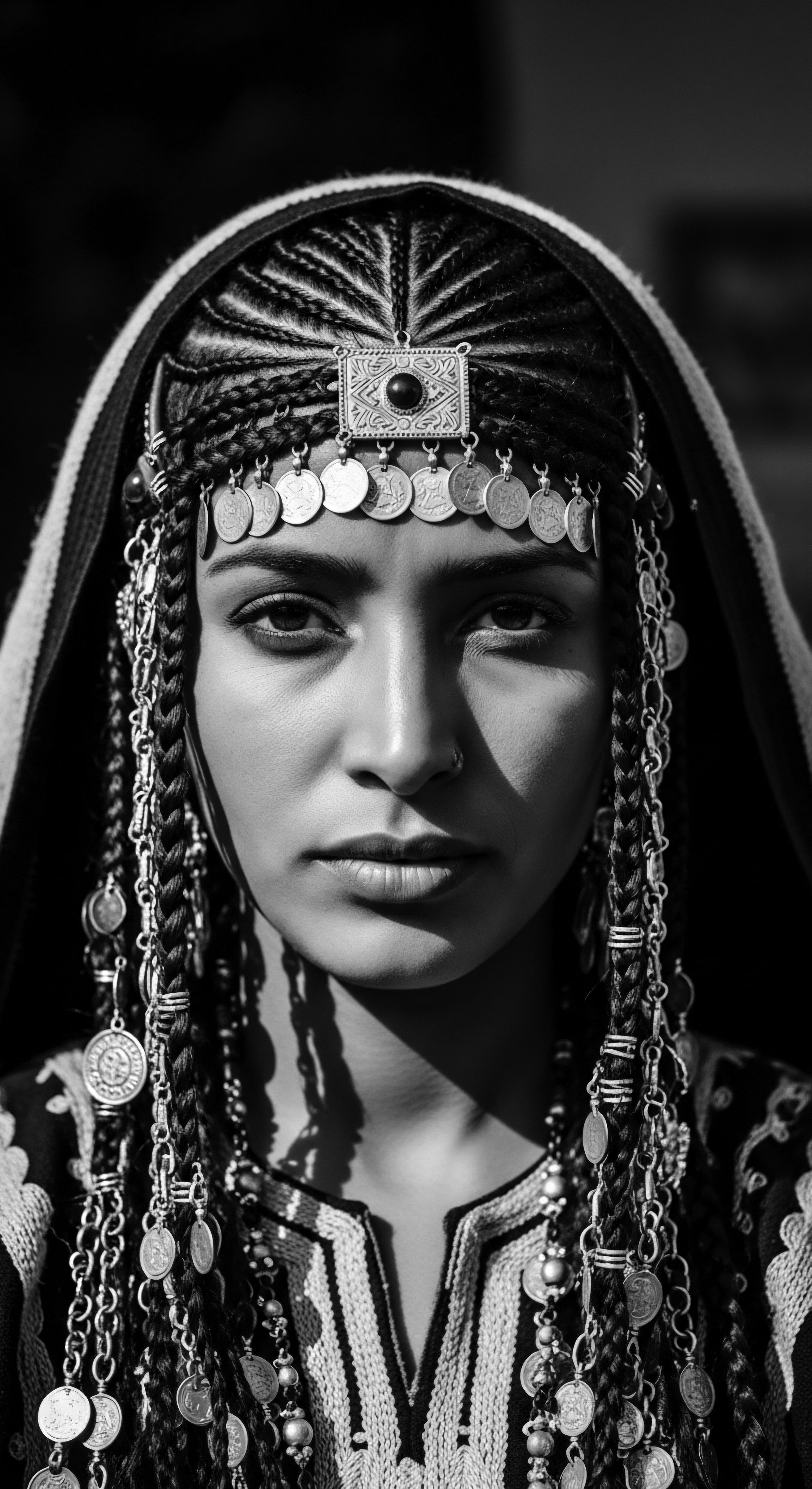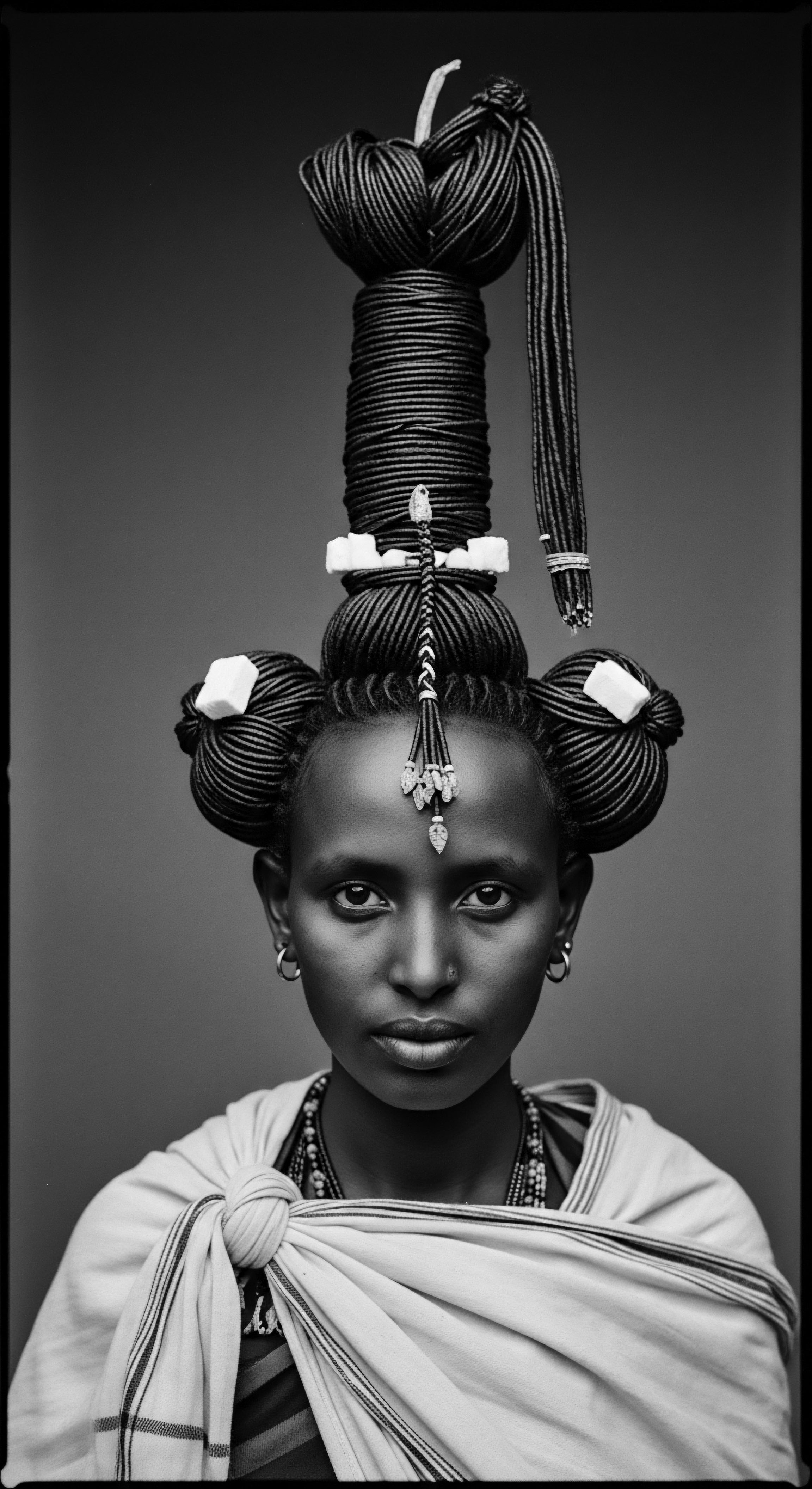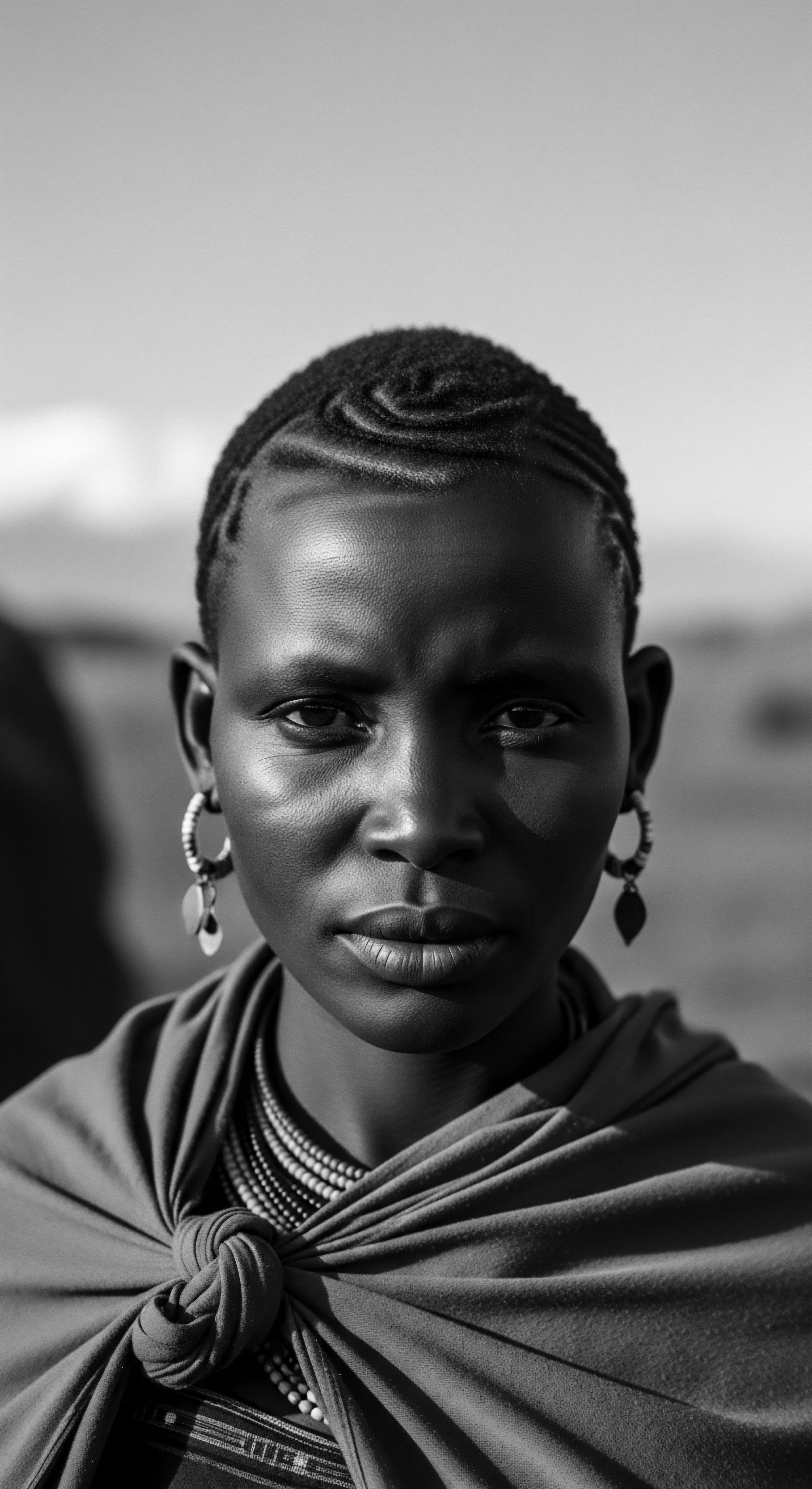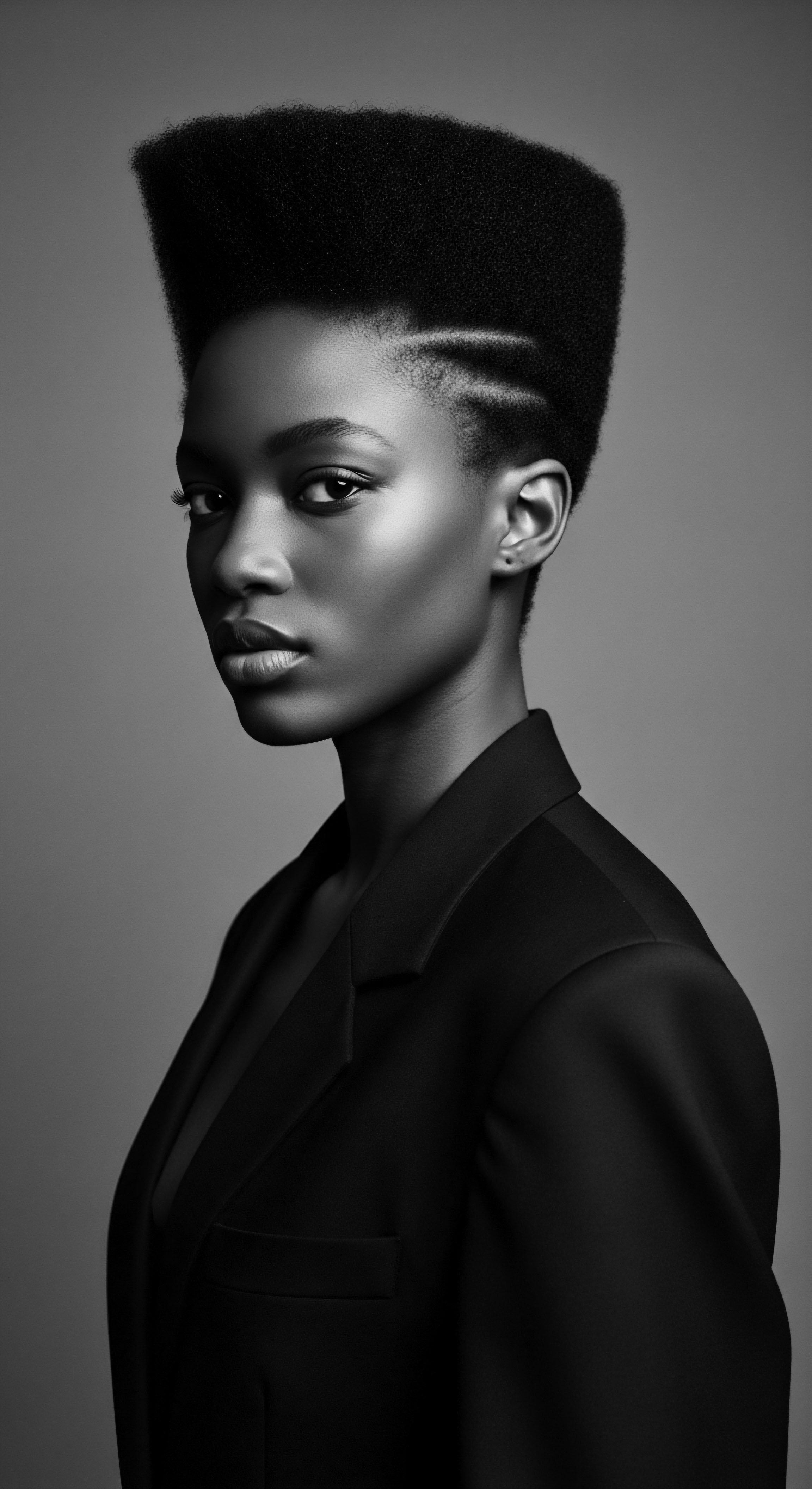
Roots
Consider the deep forest exhale of the Amazon, a breath reaching across continents, touching every curl and coil that springs from ancestral lineage. Within this verdant embrace lie secrets, not whispered, but held in the very molecular structure of the oils revered for centuries. For those of us navigating the intricate textures of our hair, from the softest wave to the most resilient coil, a deep, abiding curiosity often arises ❉ how do the practices of our forebears, particularly those involving the precious Amazonian oils, continue to shape the health and spirit of our modern strands? This inquiry extends beyond simple botanical curiosity; it reaches into the heart of what it means to carry a heritage of vibrant, strong hair, a heritage steeped in wisdom passed through generations.

Ancestral Connections to Hair’s Biology
Textured hair, with its unique structural patterns and cuticle arrangements, possesses distinct needs. Its spiraling form naturally limits the flow of natural scalp oils down the hair shaft, making it more prone to dryness. This inherent biology makes it particularly receptive to external nourishment. Long before modern scientific instruments could map protein structures or analyze lipid profiles, ancestral communities in the Amazon understood this biological reality with an intuitive grace.
They observed the plant life around them, experimenting, learning, and codifying knowledge about what worked to support hair’s vitality. This understanding, built on centuries of close observation, forms a crucial foundation for how we consider textured hair today.
Ancestral Amazonian practices offer a profound lineage for understanding textured hair’s resilience.
The anatomy of textured hair, often characterized by its elliptical cross-section and the density of its cuticle layers, requires careful tending. Unlike straight hair, which allows oils to glide effortlessly, the bends and curves of a coiled strand mean that hydration often needs active encouragement. Ancestral peoples of the Amazon, through their sustained interaction with the rainforest, came to recognize certain botanical allies that could deeply penetrate these strands, offering suppleness and protection.

The Essential Lexicon of Ancestral Botanicals
Within Amazonian tradition, specific oils have long held a place of honor for their purported hair benefits. These are not merely ingredients; they are biological legacies, each with a unique composition that speaks to particular needs of hair.
- Pracaxi Oil (Pentaclethra macroloba) ❉ Known for its remarkably high concentration of behenic acid, around 19%, this oil brings exceptional conditioning and shine. Ancestral Amazonian people traditionally used it for hair manageability and luster.
- Andiroba Oil (Carapa guianensis) ❉ Revered in indigenous cultures as sacred, this oil holds cultural significance beyond its physical benefits. It offers antibacterial and antiseptic properties, aiding in scalp health and strengthening hair.
- Rahua Oil (Oenocarpus bataua, also known as Ungurahua) ❉ Indigenous women of the Quechua-Shuar tribes have relied on this oil for centuries. Its superfine molecules allow deep penetration into the hair cortex, strengthening damaged strands and helping maintain follicular health.
- Pataua Oil (Oenocarpus bataua) ❉ Frequently identified as Ungurahua or Sejé, this oil offers benefits for hair growth and scalp health. Rich in omega-9 fatty acids, it softens and shines hair, and aids in supporting the scalp.
- Murumuru Butter (Astrocaryum murumuru) ❉ This butter, extracted from the seeds of the murumuru palm, offers intense hydration due to its rich lauric and myristic acid content. It aids in controlling frizz and restoring hair’s natural elasticity.
- Buriti Oil (Mauritia flexuosa) ❉ A treasure trove of beta-carotene and vitamin E, this oil protects hair from environmental stressors and enhances overall strength and resilience.
- Cupuaçu Butter (Theobroma grandiflorum) ❉ Related to cacao, this butter is lauded for its ability to restore hydration and reduce protein loss in hair, making it a powerful moisturizing agent.
These oils, and many others, were not simply applied. Their selection was often guided by seasonal cycles, specific hair conditions, and a holistic perspective that saw hair health as interwoven with overall wellbeing. The extraction methods, frequently manual and ceremonial, represent a profound respect for the plant itself and the life it sustained.
| Botanical Name Pentaclethra macroloba (Pracaxi) |
| Ancestral Hair Use Manageability, shine, luster. Used for skin conditions and insect bites. |
| Contemporary Hair Benefit (Science Aligned) High behenic acid content conditions, improves combability, strengthens, helps with dandruff, protects. |
| Botanical Name Carapa guianensis (Andiroba) |
| Ancestral Hair Use Hair care, beauty elixir, sacred rituals, insect repellent. |
| Contemporary Hair Benefit (Science Aligned) Nourishes dry/damaged hair, reduces split ends, strengthens structure, hydrates, combats scalp oil, stimulates blood flow, anti-inflammatory. |
| Botanical Name Oenocarpus bataua (Rahua/Pataua) |
| Ancestral Hair Use Nourishing, strengthening hair, anti-dandruff, hair loss treatment, shine. |
| Contemporary Hair Benefit (Science Aligned) Super-fine molecules deeply penetrate cortex, fortifies weak strands, reduces breakage/split ends, supports color, enhances shine, promotes hair growth. |
| Botanical Name Astrocaryum murumuru (Murumuru) |
| Ancestral Hair Use Deep conditioning, frizz control, moisturizer. |
| Contemporary Hair Benefit (Science Aligned) Intense hydration, frizz control, restores elasticity, adds shine, strengthens hair fiber, penetrates cuticle. |
| Botanical Name Mauritia flexuosa (Buriti) |
| Ancestral Hair Use Protecting hair from sun, nourishing. |
| Contemporary Hair Benefit (Science Aligned) Rich in beta-carotene (Vitamin A) and E, UV protection, strengthens cells, reduces breakage, promotes elasticity, anti-inflammatory for scalp. |
| Botanical Name Theobroma grandiflorum (Cupuaçu) |
| Ancestral Hair Use Traditional pre-shampoo, hair regeneration. |
| Contemporary Hair Benefit (Science Aligned) Restores hydration, curbs protein loss, deeply moisturizes, softens, aids repair of damaged hair. |
| Botanical Name These ancestral oils offer a testament to enduring wisdom, their properties now recognized and affirmed by contemporary science for their profound influence on hair health and resilience. |

A Symbiotic Relationship with the Environment
The deep understanding of these plant allies arose from a way of life intrinsically tied to the rainforest. Indigenous communities recognized that their own wellbeing, and the wellbeing of their hair, was intertwined with the health of the ecosystem. The cycles of harvesting, often ceremonial and hand-gathered, ensured replenishment and respected the delicate balance of the forest.
This philosophy stands as a powerful counterpoint to many modern industrial practices. The practices involving these oils speak to a historical reverence for nature’s offerings, a reverence that saw the external application of a botanical as part of a larger ecological and spiritual dialogue.

Ritual
Beyond the fundamental properties of the oils themselves, the essence of their influence resides in the rituals woven around their application. These were not merely acts of grooming; they were moments of connection, quiet practices that affirmed identity, community, and a spiritual bond with the land. The practices involving Amazonian oils were central to daily life, marking transitions, preparing for ceremonies, and simply maintaining wellbeing.

Styling as a Cultural Narrative
The application of Amazonian oils often preceded or accompanied the creation of various textured hair styles, many of which served protective purposes. These styles, whether intricate braids, coils, or twists, minimized exposure to environmental elements, reduced mechanical stress, and allowed the nourishing properties of the oils to deeply penetrate the hair shaft. This tradition of protective styling, practiced across countless generations, speaks to a foundational understanding of hair preservation.
Consider the historical importance of hair in many Black and mixed-race cultures. Hair was a marker of status, age, marital state, and tribal identity. The care given to hair, including the anointing with specific oils, was a communal act, a time for sharing stories, wisdom, and strengthening bonds. This communal aspect, often involving elders sharing techniques with younger generations, forms a living archive of hair heritage.

How Amazonian Oils Supported Traditional Styling?
The unique characteristics of Amazonian oils lent themselves exceptionally well to traditional styling needs.
- Suppleness and Glide ❉ Oils like Pracaxi and Pataua, with their rich fatty acid profiles, reduced friction during styling, making hair more pliable and less prone to breakage when being braided or coiled.
- Moisture Sealant ❉ Butters like Murumuru and Cupuaçu created a protective barrier, locking in hydration crucial for textured hair, particularly in humid rainforest climates. This minimized frizz and helped styles retain their form.
- Scalp Health ❉ Andiroba oil, with its antibacterial and anti-inflammatory attributes, supported a healthy scalp, a fundamental requirement for consistent hair growth and comfort beneath protective styles. An irritated scalp could compromise hair health, making its soothing properties essential.
The historical use of these oils in styling rituals speaks to an intuitive understanding of hair physics. The lubrication provided by the oils allowed for smoother manipulation, reducing tangles and knots, which are common challenges for textured strands. This facilitated styles that were both aesthetic and functional, preserving hair length and strength over time.
The ritual of oil application transformed grooming into a practice of communal connection and inherited wisdom.
The tools used were simple yet effective ❉ wooden combs, fingers, and the surrounding environment itself. These tools, coupled with the ancestral oils, created a synergy that allowed for diverse styling expressions while simultaneously supporting hair’s resilience. The transformation was not simply external; it was deeply personal, reflecting identity and belonging within the community.

The Enduring Legacy of Adornment
Across various Indigenous Amazonian communities, hair adornment often held profound meaning. Feathers, seeds, and natural fibers were woven into hair, symbolizing connections to nature, spiritual beliefs, or social status. The oils, by making hair more manageable and lustrous, played a subtle but important role in preparing the hair for such adornments, ensuring the hair could withstand the manipulation without compromise. The very act of preparing the hair with oils before ornamentation was a ritual in itself, a gesture of reverence for the self and cultural expression.
The resilience of textured hair, so often celebrated today, found its genesis in these thoughtful, ancestral practices. The ability of hair to withstand environmental challenges, repeated styling, and the passage of time was bolstered by the consistent application of these protective and restorative botanicals. This enduring strength, born from deliberate care, is a direct inheritance from those who first understood the wisdom held within the Amazon’s green heart.

Relay
The lineage of ancestral Amazonian practices extends its reach into our contemporary understanding of textured hair care. This historical relay of knowledge, from ancient Amazonian forests to modern formulations, offers more than a botanical list; it presents a philosophy of hair resilience, one that honors both elemental biology and cultural continuity. The deep understanding of these oils, passed through generations, informs a holistic approach to hair health, addressing not only the physical strand but also the spirit and heritage it embodies.

Holistic Influences on Hair Well-Being
For Amazonian peoples, hair health was not an isolated concern. It was intertwined with overall physical and spiritual well-being, a concept resonating with modern holistic health practices. The preparation and application of oils often involved communal gathering, singing, and storytelling, transforming a simple act of grooming into a communal wellness ritual.
This collective care fostered not just healthy hair but strong community bonds. The sustained use of these natural resources also speaks to a deep, reciprocal relationship with the environment, where gratitude and stewardship ensure continued access to nature’s bounty.
The Amazonian Kichwa people, for instance, subject their agricultural lands and harvesting to rituals and cultural practices, part of their cosmovision, ensuring respect for the land. This reverence for the source extends to the plants themselves, acknowledging their inherent power and the wisdom they hold for human well-being. This deep ecological connection highlights how a holistic approach, encompassing environmental harmony alongside personal care, has always been central to ancestral traditions.

How do Traditional Methods Inform Contemporary Solutions for Textured Hair Challenges?
The resilience of textured hair, often subject to breakage and dryness due to its unique structure, finds compelling support in the scientific validation of these ancestral oils. Modern research begins to explain what Indigenous communities understood intuitively for centuries.
For example, a study examining the effects of Cupuaçu butter on dyed hair samples showed that it significantly restored hair hydration and curbed protein loss, a common result of chemical processes. This scientific observation lends weight to traditional applications of Cupuaçu butter, such as its use as a “restructuring butter” for damaged hair. Such findings underscore the enduring wisdom of ancestral choices, revealing how traditional applications, honed through generations of empirical observation, align with contemporary biochemical understanding of hair repair and hydration.
The journey of Amazonian oils from ancestral ritual to modern science illuminates enduring wisdom for hair’s strength.
The rich fatty acid profiles in oils like Pracaxi and Pataua are now understood to provide deep conditioning and strengthen the hair cuticle, reducing friction and aiding in length retention. Pracaxi oil, with its remarkable 19% behenic acid content, offers superior conditioning properties that enhance combability and softness, a performance equivalent to traditional synthetic conditioning agents at the same concentration. This offers a clear link between ancestral experience and modern cosmetic efficacy, demonstrating how ancient wisdom translates into tangible benefits for hair resilience today.
| Oil Pracaxi Oil |
| Ancestral Observation / Use Applied for shine, manageability, and to help with combing. |
| Modern Resilience Impact (Scientific Understanding) High behenic acid content offers conditioning, reducing friction and tangles; protects against environmental damage, promotes scalp health. |
| Oil Andiroba Oil |
| Ancestral Observation / Use Used for hair care, especially dry/damaged hair, and for soothing skin conditions. |
| Modern Resilience Impact (Scientific Understanding) Contains essential fatty acids, vitamin E, and phytosterols; penetrates hair shaft for hydration, reduces inflammation, stimulates circulation for growth. |
| Oil Rahua Oil |
| Ancestral Observation / Use Reliably used to nourish and strengthen hair, often in ceremonial contexts. |
| Modern Resilience Impact (Scientific Understanding) Super-fine molecular structure allows deep penetration to repair hair cortex, fortifies strands, reduces breakage and split ends, aids in color retention. |
| Oil Pataua Oil |
| Ancestral Observation / Use Applied as a hair tonic to promote growth and health, and to address hair loss. |
| Modern Resilience Impact (Scientific Understanding) Rich in omega-9 fatty acids and antioxidants; strengthens hair's internal structure, nourishes scalp, enhances growth phase (anagen), improves hair elasticity, reduces split ends. |
| Oil Murumuru Butter |
| Ancestral Observation / Use Cherished for moisturizing, frizz control, and enhancing hair's natural elasticity. |
| Modern Resilience Impact (Scientific Understanding) High in lauric and myristic acids; deeply penetrates hair shaft for intense hydration, forms protective coating to control frizz, restores damaged hair. |
| Oil Buriti Oil |
| Ancestral Observation / Use Historically used for sun protection and hair nourishment. |
| Modern Resilience Impact (Scientific Understanding) Abundant in beta-carotene and vitamin E; provides antioxidant protection against UV damage and pollution, strengthens hair cells, improves elasticity, reduces breakage. |
| Oil Cupuaçu Butter |
| Ancestral Observation / Use Used for hair regeneration and to combat chemical damage. |
| Modern Resilience Impact (Scientific Understanding) Rich in saturated and monounsaturated fatty acids; penetrates hair shaft to restore hydration, curbs protein loss, provides softness and manageability. |
| Oil The enduring efficacy of these Amazonian oils, recognized for their distinct benefits over generations, continues to shape and strengthen modern hair care for textured strands, offering a compelling blend of tradition and verified science. |

Problem Solving with Ancestral Wisdom
Many common textured hair challenges, such as dryness, breakage, and scalp irritation, have ancestral parallels. Indigenous communities faced their own versions of these issues, often exacerbated by environmental exposure. Their solutions, based on readily available botanicals, demonstrate an adaptive intelligence that prioritized both immediate relief and sustained health.
The application of Andiroba oil, for instance, was traditionally used for insect protection and to soothe bites, its anti-inflammatory properties extending to scalp comfort. This ancient application directly informs modern solutions for irritated scalps prone to flaking or discomfort.
The wisdom of ancestors also extended to preventing problems before they arose. For example, Indigenous communities in the Amazon would often use specific oils or plant preparations before exposure to harsh sun or water, recognizing the need for proactive protection. This preventative mindset, a hallmark of traditional wellness, offers a profound lesson for contemporary routines. It suggests that true resilience arises not merely from repairing damage but from consistent, informed protection.

The Enduring Power of Plant-Based Care
The preference for plant-based solutions, so deeply ingrained in Amazonian ancestral practices, is a powerful legacy. It speaks to a belief in the inherent healing properties of nature, a philosophy that avoids artificial interventions in favor of symbiotic relationships with the earth. This tradition reminds us that the quest for healthy, resilient textured hair is not a modern invention but a deeply rooted aspect of human cultural heritage, with wisdom waiting to be continually rediscovered and applied.

Reflection
The echoes of ancestral Amazonian practices ripple through the present, offering not simply botanical remedies but a profound philosophy of textured hair care. It is a philosophy rooted in deep respect ❉ for the natural world, for the wisdom of elders, and for the inherent strength of our own strands. To engage with Amazonian oils is to reach back across time, connecting with a heritage that understands hair not as a mere adornment, but as a living extension of identity, culture, and spirit.
This enduring legacy reminds us that resilience in hair care, particularly for textured hair, is built on foundations laid long ago. It is a testament to the ingenious ways human communities have always sought balance and well-being within their environments. As we continue to seek vibrant, resilient hair in our modern world, the whisper of ancient Amazonian forests offers a guiding breath, encouraging us to seek connection, honor tradition, and find beauty in the deep, resonant soul of every strand.

References
- Banov, D. (2014). Pracaxi Oil. Protec Botanical Data Sheet.
- Colomas, J. (2023). Unlock Ancient Hair Care Secrets ❉ Discover Global Rituals for Lustrous Locks.
- Cosmacon. (n.d.). Buriti Fruit Oil. Cosmacon.
- Cosmacon. (n.d.). Pracaxi Oil – Pentaclethra Macroloba Seed Oil. Cosmacon.
- eBay. (n.d.). Cupuacu Butter – Hydrating & Softening for Skin & Hair.
- Ellemental. (n.d.). Murumuru butter.
- Four Visions. (n.d.). Sejé Pataua Extract ❉ Amazonian Hair and Skin Treatment.
- Healthline. (n.d.). What Is Cupuaçu? Benefits and Uses.
- Kens Apothecary. (n.d.). Legendary Amazon Oil.
- Kindlife. (n.d.). Pilgrim ❉ Amazonian Patuá Strengthening Hair Oil.
- Klorane. (n.d.). Hair Mask 3 in 1 Cupuaçu Butter Bio Nourishing and Repairing. SweetCare.
- Little Extra. (2023). 6 Benefits of Pataua Oil for Hair & Skin.
- Loba Mane. (2024). The Ultimate Hair Elixir ❉ Unveiling the Secrets of Buriti.
- Luxy Hair. (n.d.). How To Use Pracaxi Oil For Hair.
- Meraki Hair Wellness. (n.d.). How Buriti Protects & Strengthens Hair and Skin.
- MDPI. (2023). Safeguarding Intangible Cultural Heritage ❉ The Amazonian Kichwa People.
- Nature In Bottle. (n.d.). Andiroba Oil Organic – Carapa Guianensis Seed Oil.
- Natura. (n.d.). Patauá.
- OSKA Pure. (2023). Incredible Benefits of Amazonian Oils in Hair Care.
- Pilgrim India. (n.d.). Patuá Strengthening Hair Oil.
- Rahua. (n.d.). FAQ. rahua.com.
- Rahua. (n.d.). Legendary Amazon Oil. rahua.com.
- Rahua. (n.d.). Our Truth. rahua.com.
- Sacred Blend. (n.d.). Andiroba Oil.
- Sister Sky. (2019). The Significance Of Hair In Native American Culture.
- Substack. (2025). Cannabinoid-like Actives from the Amazon ❉ The Science of Brazilian Plants in Skin, Scalp, and Hair Care.
- The Glo Haus. (2025). 5 Reasons Why We Love Pracaxi Oil.
- The Organic Magazine. (n.d.). Rahua ❉ From the heart of the Amazon to the world.
- The Soapery. (n.d.). Pracaxi Oil.
- W. Ulrich GmbH. (n.d.). Andiroba oil.
- Love Beauty and Planet. (n.d.). What Is Murumuru Butter for Hair ❉ Benefits and Uses.
- Clinikally. (2023). Revitalize Your Locks ❉ Exploring the Wonders of Murumuru Butter for Hair.
- Naissant. (n.d.). Amazonian Rehab Hair Care Puzanga Butter.
- O&3. (n.d.). Andiroba Oil, Cold Pressed.
- Bluemercury. (n.d.). Rahua Legendary Amazon Oil.
- Fabulive. (n.d.). Rediscovering Historical Hair Care Practices.
- Andean Great Treks. (n.d.). Traditions & Culture of Iquitos-Indigenous people of Iquitos.
